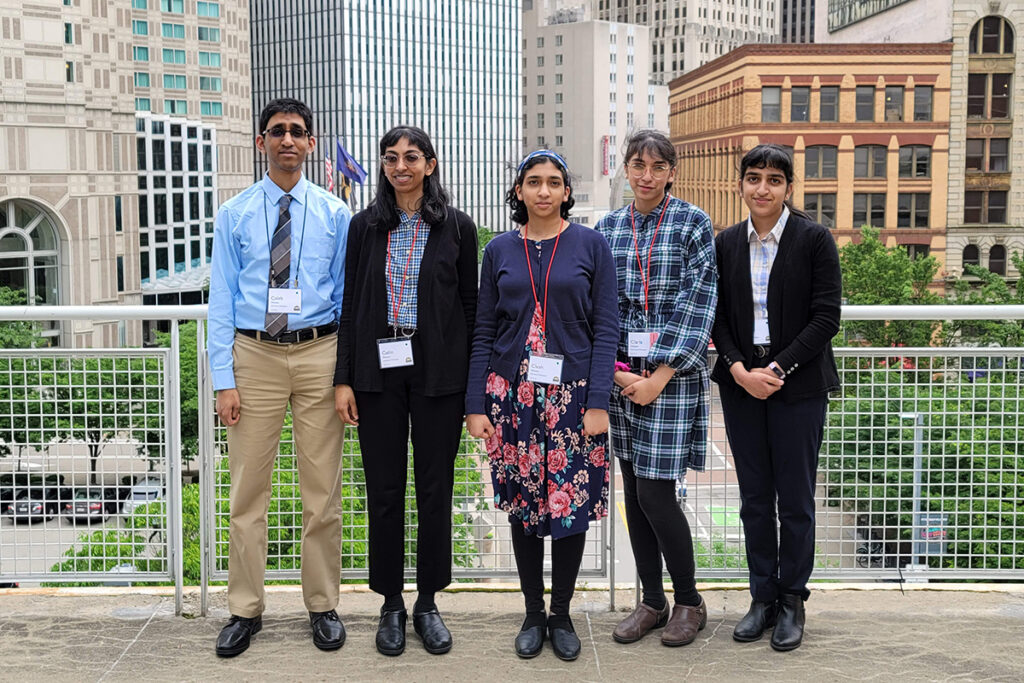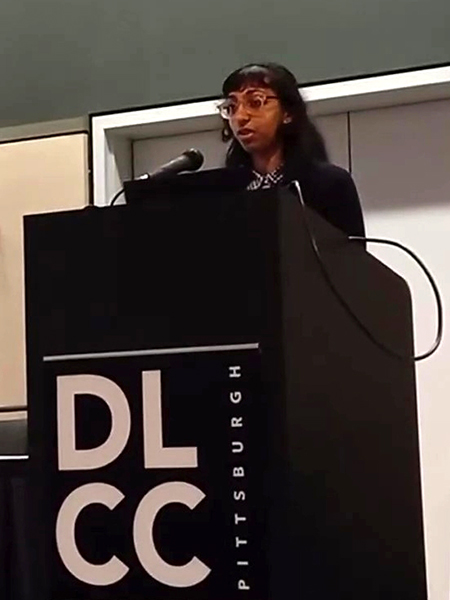
Back in May, a group of five student researchers advised by Allen School professors Rajesh Rao and René Just disembarked in Pittsburgh, Pennsylvania for the 44th International Conference on Software Engineering. They had traveled to ICSE 2022 from Seattle to present a paper describing a methodology they had developed at the University of Washington for detecting and repairing faults in brain-computer interfaces (BCIs), which are designed to enhance or restore sensorimotor function in people with neurological disorders or spinal cord injury.
The paper, “Repairing brain-computer interfaces with fault-based data acquisition,” was noteworthy for its contributions toward ensuring that BCIs, which decode or encode neural signals to mediate the connection between the brain and assistive devices, are safe and robust for everyday use. The team was noteworthy for their connection with each other: All five student co-authors — Cailin, twins Caleb and Chloe, Claris, and Cleah — are siblings. And all five were, or were about to become, Allen School majors.
The research that prompted the ICSE paper had its roots in a project initiated by four of the siblings during Rao’s neural engineering capstone course last year. While Rao appreciated the novelty of so many siblings working on the same project, he was most appreciative of their ambition and ingenuity in tackling an open problem in neural software engineering with the potential to significantly improve people’s quality of life.
“The field of BCIs is still in its early stages, with most researchers focusing on proof-of-concept demonstrations,” said Rao, co-director of the Center for Neurotechnology and the Cherng Jia and Elizabeth Yun Hwang Professor in the Allen School and the UW Department of Electrical & Computer Engineering. “I was therefore surprised and impressed when the Winston team proposed a forward-looking class project seeking to apply state-of-the-art techniques in software engineering to the design and implementation of BCIs.”
Recent Allen School alum Cailin Winston (B.S., ‘20, M.S., ‘22) — the eldest of the Winston siblings — developed and evaluated components of the team’s approach, which applies widely accepted methods for automated software testing and debugging, such as partial test oracles for detecting faults, corrective heuristics for labeling faulty data and slice functions for localizing faults, to the nascent domain of BCIs. The acquired data is then used to retrain the model to correct its performance of fault-prone tasks or used to suggest additional classes of data to target data collection and labeling. A student in the Allen School’s fifth-year master’s program at the time of publication, Cailin was already keenly aware of the importance of software and computational methods to biomedical research. That awareness prompted her to seek out ways to explore the intersection of the two disciplines early in her academic career.
“I initially got involved by contacting research groups at the University of Washington with prior publications that piqued my interest,” explained Cailin, who joined NVIDIA as a Deep Learning Engineer after graduation. “Attending research talks and colloquiums also made me aware of the various research projects being carried out and allowed me to further my involvement.”
As it turns out, the people who would take her involvement furthest — all the way to Pittsburgh as first author of a major conference paper — were closest to home. Her brother, Caleb Winston (B.S., ‘22), was also eager to find a pathway into research; in his case, it was a weekly reading group focused on the latest program synthesis papers organized by graduate students in the Allen School’s Programming Languages & Software Engineering (PLSE) group that set him on his way. Fast forward a few years, and Caleb and Cailin are collaborating on a methodology for real-time debugging and repair of BCIs and writing a paper accepted to one of the top conferences in the field.
In addition to sharing responsibilities for aspects of the ICSE paper, Caleb also shared his sister’s interest in how computing intersects with biomedicine — along with many other fields.
“Computer science intersects with so many different fields of study, from law, to healthcare, to urban planning,” noted Caleb, who is currently pursuing a Ph.D. in Computer Science at Stanford University after graduating from the Allen School in the spring. “This generalizability is what excites me to study programming languages, software engineering, AI and hardware/software systems. Simple ideas from these subfields have potentially impactful applications in many fields outside of computing.”
Claris Winston, who is now in her third year at the UW, became intrigued by the connection between computing and biomedicine in part by her experience working on a mobile app for scoliosis treatment as well as her experience participating in a summer computing camp organized by Girls Who Code. After earning direct admission to the Allen School as a freshman, she worked with members of the Molecular Information Systems Lab (MISL) on a new combinatorial polymerase chain reaction method for efficient retrieval of DNA oligo pools. That work, for which Claris was first author, was presented in a journal, in which her graphic design was also featured on the front cover. As she subsequently discovered at ICSE, presenting her research at a conference offered an entirely different — and exhilarating — experience.
“It was exciting to see researchers from all over the world and with such diverse backgrounds,” said Claris, who currently works with Allen School professor Jennifer Mankoff in the Make4All Group on research related to optimization for embroidered tactile graphics. “I was impressed by the range of topics covered, and the talks themselves had so many creative ideas and applications in the field.”
Youngest sibling and current freshman Cleah Winston contributed to the ICSE paper even before she arrived at the UW. She credits this and other early research experiences with opening her eyes to how an Allen School education would help her reach her goal of creating real-world impact.
“After being involved in several research projects in high school, I realized how much I enjoyed designing and developing solutions to problems in society,” she explained. “I felt that studying computer science would give me the tools and thought process for designing such solutions.”
The BCI project certainly gave her a head start in that regard, where she collaborated with sisters Claris and Chloe Winston (B.S., ‘22) in implementing a set of neural decoding BCI applications and using focused data acquisition and data labeling techniques to evaluate the team’s methodology for testing and repairing BCIs. Cleah is currently working with Allen School professor Byron Boots in the Robot Learning Lab exploring neural networks for computer vision and applications for hazard avoidance for off-road autonomous vehicles.
Chloe, who also took the lead on the statistical analysis of the results, credited an “internship-like class” in biotechnology research that she took in high school with setting her on a path to research at the UW. Her experience in the Garden Laboratory, in UW Medicine’s Department of Neurology, further fueled her love for research.
“I enjoyed the process of formulating research questions and designing and conducting experiments,” said Chloe, who double-majored in computer science and neuroscience at the UW. “That experience led me to seek other research opportunities throughout my undergraduate years.”
The two senior authors, Rao and Just, saw to it that all five student researchers would be able to attend the conference in person. While the siblings enjoyed the thrill of presenting their work to more senior researchers, their first conference experience was memorable for a variety of other reasons.
“I especially enjoyed the talks in the ‘Human Aspects of Software Engineering’ session, in which the social and cognitive aspects of the field were discussed,” said Claris. “Many of these topics were ones that I had not thought deeply about before, but this research is very important to study so we can build better engineering communities and software that benefits everyone.”
Chloe, meanwhile, found the conference eye-opening for the breadth of research happening in software engineering and the diverse problems it is trying to solve. The experience also impressed upon her the importance of researchers showing up to share their work. It’s a lesson she took with her to the University of Pennsylvania, where she is pursuing a M.D./Ph.D. with the goal of incorporating deep learning techniques into biomedical research and patient care as a physician-scientist.
“The conference environment was highly collaborative, and I was impressed by how new ideas were sparked through presentation and discussion,” she said. “Despite the inconvenience of travel and the anxiety that can come with presenting, I aim to continue attending and presenting at conferences. This is how new research directions are formed.”
For Caleb, ICSE offered a chance to bring what, at this point, could arguably be referred to as “the family business” full circle.
“The first time we all worked on a research project together was in high school. We were printing, cutting, and taping together a poster on precision medicine the night before a science fair,” he recalled. “It’s exciting to think that we have gone from working on high school science fair projects to cutting-edge research at the intersection of neural engineering and software engineering, which led to us presenting at ICSE.”
Read the team’s research paper here and the siblings’ retrospective on ICSE 2022 here.


